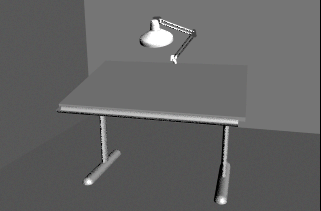Maya
has many types of lights that simulate natural and artificial lighting.
In the next steps, you create a light for the scene using a directional
light. A directional light uses parallel rays of light,
as if illuminating from a very far distance, to illuminate the scene.
A directional light is often used to simulate sunlight.
To create a directional light
- Select
Create > Lights > Directional light >
 .
.
- Turn off Interactive Placement,
then click Create.
A directional
light is created at the center of the scene.
Because a directional light
is similar to sunlight. Its parallel rays strike all objects in
the scene from a single direction as indicated by the arrow icon representing
the light. The position of the light is not so much important as
the direction that the arrow icon points.
When you create a light,
the scene view does not display its effect, by default. The scene
view instead uses default lighting.
- Select Lighting > Use All
Lights (Hotkey: 7). This lights up the scene view only
with lights you’ve created, not with default lighting. If you later
want to see the scene view with default lighting again, select Lighting
> Use Default Lighting (Hotkey: 6).
When you render the scene,
by default, Maya uses all lights you’ve created. If you don’t create
any lights, Maya creates a temporary default directional light for
you and then deletes it when the render is complete.
Next, you aim the directional
light and edit its attributes.
To edit the directional light
- With
the directional light selected, rotate the light in various directions. The
shading of surfaces changes as you rotate the light. The more directly the
light points at a surface, the brighter the shading. A directional
light is affected by its rotation, not its position. As you’ll see
later, the position of other lights affects the lighting.
- Rotate the light as follows:
- Rotate X:
-40
- Rotate Y:
25
- Rotate Z:
-20
With this orientation,
all object surfaces in the scene show the effect of the light in
the current camera view.
- With the light still selected, open the Attribute
Editor (under the Window menu).
Drag the Intensity slider to various
values to see the effects of intensity.
Higher values brighten
the surfaces. For example, an Intensity of 1.6 brightens the lighting
so much that the gray default shading of some surfaces are bleached
to white.
NoteSeveral of the following
illustrations in this lesson are snapshots of the scene after rendering.
To render the scene, select
Render > Render Current Frame.
Do not use IPR rendering for this lesson because it doesn’t automatically
update the image for some of the changes you make to the scene.
- In the Attribute Editor,
click the white Color box above the Intensity box. This
displays the Color Chooser.
- Click inside the color wheel (hexagon)
and drag the pointer to a red color.
The lighting imparts
a red hue to the surfaces in the scene.
Move your mouse off the Color
Chooser to exit.
- Change the color back to white and set
the Intensity to 1.2 or so.
You’ll use these settings
for the basic lighting of the scene.
 .
.

